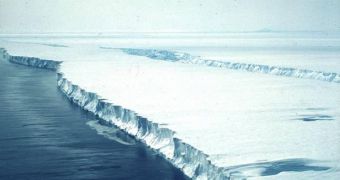According to scientific evidence seen by the BBC News, it would appear that one of the largest ice sheets in the Antarctic, Pine Island Glacier, is melting four times faster than it did only ten years ago. Satellite measurements of the region have revealed the fact that the formation is at this time losing about 16 meters of ice every year, which is a lot more than the regional average. The sheet is located in the western part of Antarctica, a region that is known for its rapid melting.
The discovery bears terrible implications for the safety of people living in low-lying coastal areas. Statistics show that the glacier has dropped about 90 meters in height since 1994, when measurements began, and most of the ice that falls off of it contributes to rising the level of the world's seas and oceans. The team of UK experts that made the find was led by University College London (UCL) professor Duncan Wingham. Details of their investigations appear in the latest issue of the respected scientific journal Geophysical Research Letters.
The main problem with the glacier is not necessarily that it's losing ice, but the fact that most thinning occurs at its center. This increases the danger of it simply snapping into two, and drifting at sea. If this happens, ice further inland, which is held back by this shelf, could also begin to drift towards the sea, in a domino effect of sorts. While previous calculations showed that Pine Island Glacier might last up to 600 years at a steady melt rate, the new research reveals that it may only have 100 years to go before it is all gone. Experts believe that molten ice from the center of the glacier could by itself raise sea levels by up to 3 centimeters.
“But the ice trapped behind it is about 20-30cm of sea level rise and as soon as we destabilize or remove the middle of the glacier we don't know really know what's going to happen to the ice behind it. This is unprecedented in this area of Antarctica. We've known that it's been out of balance for some time, but nothing in the natural world is lost at an accelerating exponential rate like this glacier,” tells the news outlet Leeds University expert, professor Andrew Shepherd, one of the study authors.
“The science community has been surprised by how sensitive these large glaciers are to climate warming. First it was the glaciers in south Greenland and now as we move further north in Greenland we find retreat at major glaciers. It's like removing a cork from a bottle,” concludes Ohio State University (OSU) expert, professor Jason Box.

 14 DAY TRIAL //
14 DAY TRIAL //